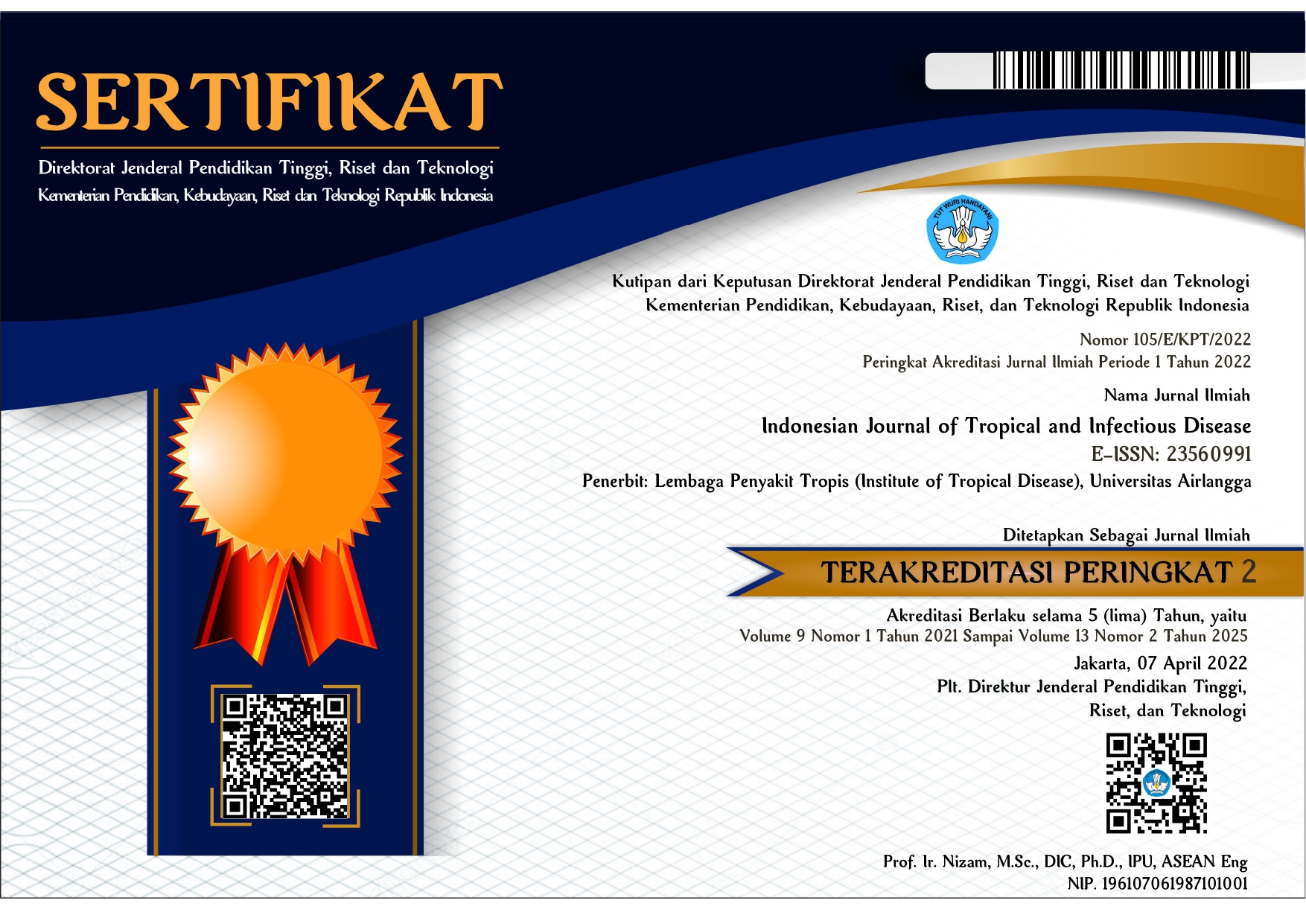Profile of Nontuberculous Mycobacteria and Mycobacterium tuberculosis Detected in the Sputum of Pulmonary Tuberculosis Re-treatment Patients at Dr. Soetomo General Hospital
Downloads
Tuberculosis (TB) remains one of the leading infectious diseases worldwide. Despite global efforts to control TB, it remains a major public health issue, affecting 10.6 million people annually in 2021, with significant morbidity and mortality, particularly in resource-limited settings. Effective treatment of TB requires strict adherence to long-term medication, but challenges such as treatment failure, relapse, and loss to follow-up complicate outcomes. This is especially concerning for patients with comorbidities such as diabetes, HIV, or hypertension, which not only increase the risk of TB but also hinder its treatment and elevate the likelihood of nontuberculous mycobacteria (NTM) infections. This study aimed to analyze 326 pulmonary TB retreatment cases at Dr. Soetomo General Academic Hospital from October 2023 to April 2024. The retrospective design identified that 323 cases involved MTB and 3 involved NTM. The findings show that loss to follow-up was the most common reason for retreatment, particularly among males and older adults. Comorbidities were found to exacerbate treatment challenges, with some retreatment cases lasting up to 24 months. The study concludes that loss to follow-up remains a major risk factor for TB retreatment, particularly in MTB cases, and highlights the importance of managing comorbidities to improve treatment outcomes.
WHO. Global Tuberculosis report. WHO, 2022.
Getnet F, Sileshi H, Seifu W, Yirga S, Alemu AS. Do retreatment tuberculosis patients need special treatment response follow-up beyond the standard regimen? Finding of five-year retrospective study in pastoralist setting. BMC Infect Dis, 2017;17(1). doi:10.1186/s12879-017-2882-y
Dinas Kesehatan Provinsi Jawa Timur. Profil Kesehatan 2021.
Bell L, Noursadeghi M. Pathogenesis of HIV-1 and Mycobacterium tuberculosis co-infection. Nat Rev Microbiol. 2018;16(2):80–90. doi: 10.1038/nrmicro.2017.128
Molina-Romero C, Arrieta O, Hernández-Pando R. Tuberculosis and lung cancer. Salud Publica Mex. 2019 May-Jun;61(3):286–91. doi: 10.21149/10090
Al-Rifai RH, Pearson F, Critchley JA, Abu-Raddad LJ. Association between diabetes mellitus and active tuberculosis: A systematic review and meta-analysis. PLoS One. 2017 Nov 21;12(11):e0187967. doi: 10.1371/journal.pone.0187967
Adane HT, Howe RC, Wassie L, Magee MJ. Diabetes mellitus is associated with an increased risk of unsuccessful treatment outcomes among drug-susceptible tuberculosis patients in Ethiopia: A prospective health facility-based study. J Clin Tuberc Other Mycobact Dis. 2023 Apr 11;31:100368. doi: 10.1016/j.jctube.2023.100368
Gopalaswamy R, Shanmugam S, Mondal R, Subbian S. Of tuberculosis and non-tuberculous mycobacterial infections - A comparative analysis of epidemiology, diagnosis and treatment. J Biomed Sci. 2020; 27(1). doi:10.1186/s12929-020-00667-6
Loebinger MR, Quint JK, van der Laan R, Obradovic M, Chawla R, Kishore A, et al. Risk factors for nontuberculous mycobacterial pulmonary disease/ Chest, 2023;164(5): 1115–24. doi:10.1016/j.chest.2023.06.014
Cowman S, van Ingen J, Griffith DE, Loebinger MR. Non-tuberculous mycobacterial pulmonary disease. Eur Respir J. 2019;54(1):1900250. doi: 10.1183/13993003.00250-2019
Drummond WK, Kasperbauer SH. Nontuberculous Mycobacteria: Epidemiology and the impact on pulmonary and cardiac disease. Thorac Surg Clin. 2019 Feb;29(1):59-64. doi: 10.1016/j.thorsurg.2018.09.006
Sarpal SS, Goel NK, Kumar D, Janmeja AK. Gender disparities in pengobatan ulang patients of tuberculosis: A north Indian study. J Nat Sci Biol Med. 2015 Jan-Jun;6(1):63-6. doi: 10.4103/0976-9668.149087
Santos E, Felgueiras Ó, Oliveira O, Duarte R. Factors associated with loss to follow-up in Tuberculosis treatment in the Huambo Province, Angola. Pulmonology 2019;25(3):190–2. doi:10.1016/j.pulmoe.2019.03.003
Ryu YJ, Koh W J, Daley CL. Diagnosis and Treatment of Nontuberculous Mycobacterial Lung Disease: Clinicians’ Perspectives. Tuberc Respir Dis, 2016; 79(2):, 74. doi:10.4046/TRD.2016.79.2.74
Gnanadurai R, Ninan MM, Arul AO, Sam AS, James P, Gupta R, et al. Challenges in the management of slowly growing non-tuberculous mycobacteria causing pulmonary disease: Perspectives from a high burden country. Indian J Med Microbiol. 2021 Oct-Dec;39(4):446-50. doi: 10.1016/j.ijmmb.2021.07.005
Khawbung JL, Nath D, Chakraborty S. Drug resistant Tuberculosis: A review. Comp Immunol Microbiol Infect Dis. 2021 Feb; 74:101574. doi: 10.1016/j.cimid.2020.101574
Strydom N. Gupta SV, Fox WS, Via LE, Bang H, Lee M, et al. 'Tuberculosis drugs’ distribution and emergence of resistance in patient’s lung lesions: A mechanistic model and tool for regimen and dose optimization,' PLoS Medicine, 2019; 16(4): e1002773. doi:10.1371/journal.pmed.1002773
Tan Y, Deng Y, Yan X, Liu F, Tan Y, Wang Q, et al. Nontuberculous mycobacterial pulmonary disease and associated risk factors in China: A prospective surveillance study. J Infect.2012; 83(1): 46–53. doi:10.1016/j.jinf.2021.05.019
Chu, H, Zhao L, Xiao H, Zhang Z, Zhang J, Gui T, et al. (Systematic review/Meta-analysis Prevalence of nontuberculous mycobacteria in patients with bronchiectasis: a meta-analysis/ Arch Med Sci. 2014; (10(4): 661–8. doi:10.5114/aoms.2014.44857
Adé S, Adjibodé O, Wachinou P, Toundoh N, Awanou B, Agodokpessi G, et al. Characteristics and treatment outcomes of pengobatan ulang tuberculosis patients in Benin. Tuberc Res Treat, 2016; 1–7. doi:10.1155/2016/1468631
Saptawati L, Kusumo H, Suryawati B. Prevalence of non-tuberculous mycobacteria (NTM) in Surakarta, Indonesia: higher than expected. KnE Life Sci. (2019); 4(12):132. doi:10.18502/kls.v4i12.4166
Nidoi J, Muttamba W, Walusimbi S, Imoko JF, Lochoro P, Ictho J, et al. Impact of socio-economic factors on Tuberculosis treatment outcomes in north-eastern Uganda: A mixed methods study. BMC Pub Health. 2021 Nov 26;21(1):2167. doi: 10.1186/s12889-021-12056-1
Xu J, Li P, Zheng S, Shu W, Pang Y. Prevalence and risk factors of pulmonary nontuberculous mycobacterial infections in the Zhejiang Province of China. Epidemiol Infect. 2019 Sep 11;147:e269. doi: 10.1017/S0950268819001626
Karthikeyan V, Ganapathy K. Determinants of Categories of TB Pengobatan ulang with Special Reference to Sources of Primary Anti-TB Treatment. J Health Allied Sci NU, 2020; 10(3): 116–21. doi:10.1055/s-0040-1716313
Marçôa R, Ribeiro AI, Zão I, Gomes M, Gaio AR, Duarte R. Erratum to: Tuberculosis and gender – factors influencing the risk of tuberculosis among men and women by age group. Pulmonology. 2019;25(4):258. doi: 10.1016/j.pulmoe.2018.10.002
Smith GS, Van Den Eeden SK, Baxter R, Shan J, Van Rie A, Herring AH, et al. Cigarette smoking and pulmonary tuberculosis in northern California. J Epidemiol Community Health. 2015;69:568-73.
Krishna S, Jacob JJ. Diabetes mellitus and tuberculosis. . In: Feingold KR, Ahmed SF, Anawalt B, Blackman MR, Boyce A, Chrousos G, et al. (eds), Endotext. South Dartmouth (MA): 2021.
Bell L, Noursadeghi M. Pathogenesis of HIV-1 and Mycobacterium tuberculosis co-infection. Nat Rev Microbiol. 2018; 16(2): 80–90. doi:10.1038/nrmicro.2017.128
Seegert AB, Rudolf F, Wejse C, Neupane D. Tuberculosis and hypertension-a systematic review of the literature. Int J Infect Dis. 2017 Mar;56:54–61. doi: 10.1016/j.ijid.2016.12.016
Lamplugh ZL, Fan Y. Vascular microenvironment, tumor immunity and immunotherapy,' Front Immunol. 2021; 12. doi:10.3389/fimmu.2021.811485
Preda M, Tănase BC, Zob DL, Gheorghe AS, Lungulescu CV, Dumitrescu EA, et al. The bidirectional relationship between pulmonary tuberculosis and lung cancer. Int J Environ Res Public Health. 2023 Jan 10;20(2):1282. doi: 10.3390/ijerph20021282
Boadu AA, Asare P, Mosi L, Mantey EA, Gbadamosi KM, Eleeza JA, et al. Tuberculosis and diabetes mellitus: The complexity of the comorbid interactions. Int J Infect Dis. 2024;146:107140. doi: 10.1016/j.ijid.2024.107140
Wotale TW, Lelisho ME, Negasa BW, Gelan LG, Adugna AG. Identifying risk factors for recurrent multidrug resistant tuberculosis based on patient’s record data from 2016 to 2021: Retrospective study. Sci Rep. 2024;14:23912. doi: 10.1038/s41598-024-73209-x
Soeroto AY, Pratiwi C, Santoso P, Lestari BW. Factors affecting outcome of longer regimen multidrug-resistant tuberculosis treatment in West Java Indonesia: A retrospective cohort study. PloS One, 2021; 16(2): e0246284. doi:10.1371/journal.pone.0246284
Daley CL. Iaccarino JM, Lange C, Cambau E, Wallace RJ Jr, Andrejak C, et al. Treatment of Nontuberculous mycobacterial Pulmonary Disease: An Official ATS/ERS/ESCMID/IDSA Clinical Practice Guideline. Eur Respir J. 2020 Jul 7;56(1):2000535. doi: 10.1183/13993003.00535-2020
Mahtab S, Coetzee D. Influence of HIV and other risk factors on tuberculosis. SAMJ. South African Med J. 2017; 107(5): 428. doi:/10.7196/samj.2017.v107i5.11271
Bhattacharyya P, Saha D, Bhattacherjee PD, Das SK, Bhattacharyya PP, Dey R. Tuberculosis associated pulmonary hypertension: The revelation of a clinical observation. Lung India. 2016 Mar-Apr;33(2):135-9. doi: 10.4103/0970-2113.177433.
Huamán MA, Henson D, Ticona E, Sterling TR, Garvy BA. Tuberculosis and cardiovascular disease: linking the epidemics,' Trop Dis. Travel Med Vaccines 2015;1(1).doi: 10.1186/s40794-015-0014-5
Khan AF Sajjad A, Mian DA, Tariq MM, Jadoon UK, Abbas M, et al. Co-infection with hepatitis B in tuberculosis patients on anti-tuberculosis treatment and the final outcome. Cureus. 2021 Apr 12;13(4):e14433. doi: 10.7759/cureus.14433
Lin Y, Lin H, Xiao L, Chen Y, Meng X, Zeng X, Chang C, Brigden G. (.Tuberculosis recurrence over a 7-year follow-up period in successfully treated patients in a routine program setting in China: a prospective longitudinal study. Int J Infect Dis. 2021 Sep;110:403-409. doi: 10.1016/j.ijid.2021.07.057.
Siddiqui A, Khayyam KU. Sharma M. (Effect of Diabetes Mellitus on Tuberculosis Treatment Outcome and Adverse Reactions in Patients Receiving Directly Observed Treatment Strategy in India: A Prospective Study. Biomed Res Int. 2016;2016:7273935.doi: 10.1155/2016/7273935
Dedefo MG, Sirata MT, Ejeta BM, Wakjira GB, Fekadu G, Labata BG. Treatment Outcomes of Tuberculosis Retreatment Case and Its Determinants in West Ethiopia. Open Respir Med J. 2019 Dec 31;13:58-64. doi: 10.2174/1874306401913010058
Copyright (c) 2025 Indonesian Journal of Tropical and Infectious Disease

This work is licensed under a Creative Commons Attribution-NonCommercial-ShareAlike 4.0 International License.
The Indonesian Journal of Tropical and Infectious Disease (IJTID) is a scientific peer-reviewed journal freely available to be accessed, downloaded, and used for research. All articles published in the IJTID are licensed under the Creative Commons Attribution-NonCommercial-ShareAlike 4.0 International License, which is under the following terms:
Attribution ” You must give appropriate credit, link to the license, and indicate if changes were made. You may do so reasonably, but not in any way that suggests the licensor endorses you or your use.
NonCommercial ” You may not use the material for commercial purposes.
ShareAlike ” If you remix, transform, or build upon the material, you must distribute your contributions under the same license as the original.
No additional restrictions ” You may not apply legal terms or technological measures that legally restrict others from doing anything the license permits.























